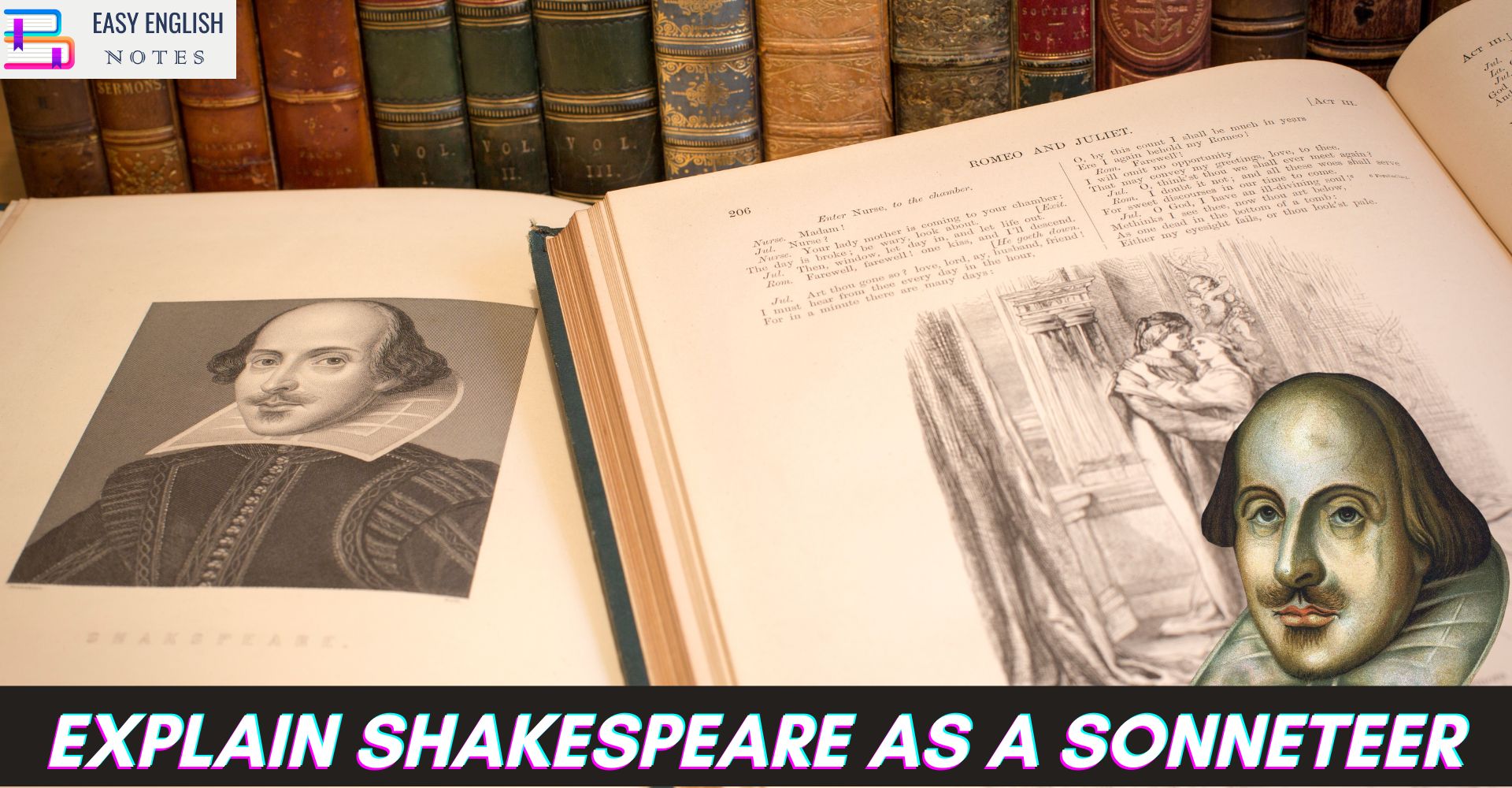Shakespeare as a Sonneteer:
William Shakespeare, widely regarded as one of the greatest playwrights in history, was also a masterful sonneteer. Sonnets are a form of poetry consisting of 14 lines, typically written in iambic pentameter, and following a specific rhyme scheme. Shakespeare composed a collection of 154 sonnets, which are among his most celebrated works.
A sonnet is a form of a poem which specifically has fourteen lines and a structured form. It was popularized in Italy where it originates; hence the Italian or Petrarchan sonnet, named after Petrarch due to his expert and extensive use of this form.
The Elizabethan or Shakespearean sonnet is so named because it was formed and became distinct from the Italian sonnet during the Elizabethan era and Shakespeare was its most prolific and famous user in writing about love. Shakespearean or Elizabethan sonnets are divided into three quatrains (four lines each) and a rhyming couplet at the end with a recognizable rhythm created by the rhyme scheme and the five stressed syllables per line (iambic pentameter).
In making use of the form of the sonnet himself, Shakespeare is credited with having penned 154 sonnets, with almost all of them following the Shakespearean format. Each sonnet largely presents an idea in each of the four line stanzas and the rhyming couplet completes the picture.
The apparent sequence which Shakespeare’s sonnets follow has been the subject of much discussion and debate among critics but the first 126 sonnets are addressed to a young man although most of the time this is not explicitly expressed and the latter section is about Shakespeare’s relationship with a woman with only the last two sonnets being adaptations of classical verse.
BUY NOW
There is no known autobiographical element to these sonnets although some critics have gone to great pains to find a connection other than his instinctive ability to create beauty and question the definitions of it from his surroundings.
Shakespeare was such an amazing sonneteer that there is actually a type of sonnet today that we refer to as a “Shakespearean Sonnet”! Even though Shakespeare isn’t the inventor of the Shakespearean sonnet, he was certainly the master of this kind of poem. Quite simply, a Shakespearean sonnet contains fourteen lines of iambic pentameter. It has three quatrains (four lines each) and a final rhyming couplet (of two lines). Therefore, the rhyme scheme is always abab cdcd efef gg. Most often a problem is presented in the first 12 lines or so with a solution following by the end of the poem.
During the Elizabethan period, writing groups of sonnets with similar themes (called a “sonnet sequence”) became very popular. Shakespeare wrote the best of these sonnet sequences, in my opinion. His contained a full 154 sonnets. They focus on a handsome young man, a rival poet, and sometimes even a “dark lady.” These subjects often cause scholars to disagree upon the truth behind Shakespeare’s life and sexuality.
One of the remarkable aspects of Shakespeare’s sonnets is the range and depth of emotions they explore. While many sonnets are dedicated to the theme of love, Shakespeare goes beyond conventional expressions of romantic love and delves into the complexities and contradictions of human relationships. He portrays the ecstasy of love, the anguish of unrequited affection, and the bittersweet nature of longing and loss.
Shakespeare’s ability to convey these intricate emotions within the confines of the sonnet form is truly extraordinary. He employs rich metaphors, striking imagery, and powerful language to capture the nuances of human experiences. His sonnets often contain a Volta, a turning point where the mood or perspective shifts, adding complexity and depth to the themes being explored.
Also Read :
- Compare Hamlet with Macbeth, Othello and other Tragedies
- “The Pardoner’s Tale” is the finest tale of Chaucer
- Prologue to Canterbury Tales – (Short Ques & Ans)
- Confessional Poetry – Definition & meaning
- Line By Line Explanation Of The Poem The Eve of St. Agnes
- 10 Proven Steps on How to Become a Self-Made Millionaire
Moreover, Shakespeare’s language in his sonnets is highly poetic and evocative. He skillfully combines rhetorical devices, such as alliteration, metaphor, and personification, to create vivid and memorable images. His use of figurative language heightens the emotional impact of his sonnets and adds layers of meaning to the words on the page.
Another aspect that sets Shakespeare apart as a sonneteer is his ability to engage with universal themes and make them resonate across time and cultures. Despite being written over four centuries ago, his sonnets continue to captivate and speak to readers today. The enduring appeal of Shakespeare’s sonnets lies in their exploration of timeless themes such as love, beauty, mortality, and the complexities of the human condition.
In addition to their literary merit, Shakespeare’s sonnets have also contributed significantly to the development of the sonnet form itself. His mastery of the Shakespearean sonnet structure, with its distinctive rhyme scheme and three-quatrains-and-a-couplet pattern, has influenced countless poets who have followed in his footsteps. His use of language, rhyme, and rhythm has become a touchstone for sonneteers across generations.
In conclusion, Shakespeare’s legacy as a sonneteer is unparalleled. Through his 154 sonnets, he showcases his mastery of poetic language, ability to convey complex emotions, and exploration of universal themes. His sonnets continue to be celebrated for their poetic beauty, intellectual depth, and emotional resonance. Shakespeare’s contributions to the sonnet form and his profound understanding of the human experience have solidified his place as one of the greatest sonneteers in literary history.
12 Life-Changing Tips on How to Stop Using Credit Cards for Good












Youre so cool! I dont suppose Ive learn anything like this before. So nice to find any person with some unique thoughts on this subject. realy thank you for starting this up. this web site is one thing that is wanted on the net, somebody with a little bit originality. helpful job for bringing one thing new to the web!